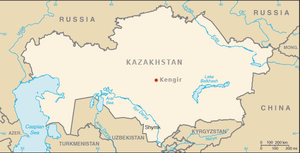This article needs editing to comply with Wikipedia's Manual of Style. (April 2024) |
| Kengir uprising | |||||||
|---|---|---|---|---|---|---|---|
 Location of Kengir in Kazakhstan | |||||||
| |||||||
| Belligerents | |||||||
|
|
| ||||||
| Commanders and leaders | |||||||
|
|
| ||||||
| Strength | |||||||
| 1,700 | 5,200 | ||||||
| Casualties and losses | |||||||
| 40 wounded |
Per USSR: 37 killed, 106 wounded | ||||||
The Kengir uprising was a prisoner rebellion that occurred in Kengir (Steplag), a Soviet MVD special camp for political prisoners, during May and June 1954. Its duration and intensity distinguished it from other Gulag rebellions during the same period, such as the Vorkuta uprising and Norilsk uprising.
After the murder of some of their fellow prisoners by guards, Kengir inmates rebelled and seized the entire camp compound, holding it for weeks and creating a period of freedom for themselves unique in the history of the Gulag. After a rare alliance between the criminals and political prisoners, the prisoners succeeded in forcing the guards and camp administration to flee the camp and effectively quarantined it from the outside. The prisoners thereafter built intricate defenses to prevent the incursion of the authorities into their newly won territory. This situation lasted for an unprecedented length of time and resulted in novel activity, including the formation of a provisional government by the prisoners, prisoner marriages, the performance of religious ceremonies, and the waging of a propaganda campaign against the erstwhile authorities.
After 40 days of freedom within the camp walls, intermittent negotiation, and mutual preparation for violent conflict, the rebellion was suppressed by Soviet armed forces with tanks and guns on the morning of 26 June.[1] According to former prisoners, five hundred to seven hundred people were killed or wounded by the suppression, although official figures claim only a few dozen had been killed. The story of the rebellion was first committed to history in The Gulag Archipelago, a work by former Gulag prisoner and Nobel Prize-winning Russian author Aleksandr Solzhenitsyn, using former Kengir prisoners as sources.
- ^ a b "Документы о восстании заключенных Степного лагеря МВД в мае-июне 1954 г." [Documents about the uprising of prisoners of the Steppe camp of the Ministry of Internal Affairs in May–June 1954]. A. N. Yakovlev Foundation (in Russian). Retrieved 19 April 2024.